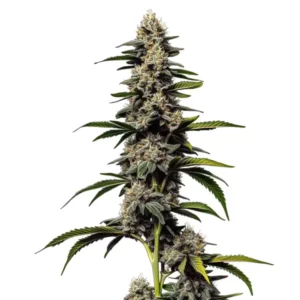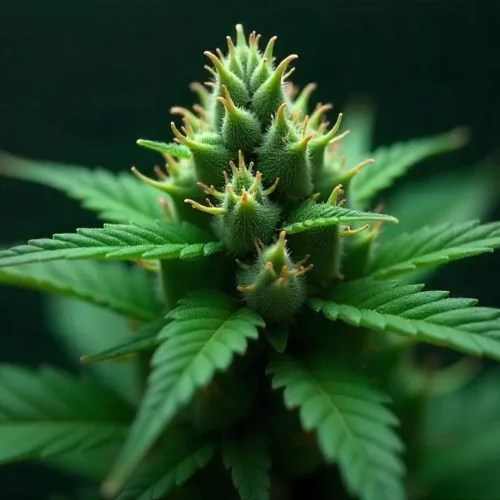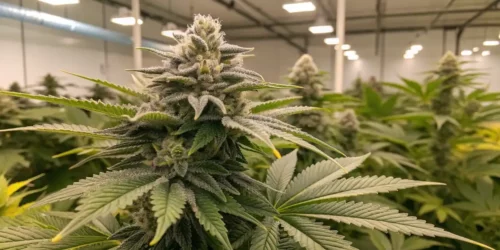You probably already have some idea of what Vapor Pressure Deficit (VPD) is, but perhaps you need a simple introduction without any formulas or math. We’ve got you covered! We’ll provide calculators, recommended ranges, and an easy-to-understand VPD Chart Weed growers can use to optimize their grow room conditions.
Many indoor growers encounter mysterious plant growth problems, such as symptoms resembling nutrient deficiencies, even when the nutrients are perfectly balanced and fresh. Other times, growers face sluggish growth, powdery mildew, or other unexplained issues that are actually related to the environment.
Recommended Strains
Cream Auto
 THC: 16 - 18%
THC: 16 - 18% Type of seed: Autoflowering
Type of seed: Autoflowering Phenotype: Mostly Indica
Phenotype: Mostly Indica Day to flower: 8 - 10 weeks
Day to flower: 8 - 10 weeks
Cream Candy Auto
 THC: 19% - 24%
THC: 19% - 24% Type of seed: Autoflowering
Type of seed: Autoflowering Phenotype: Mostly Indica
Phenotype: Mostly Indica Day to flower: 7 - 8 weeks
Day to flower: 7 - 8 weeks
The amazing thing is, adjusting for Vapor Pressure Deficit (VPD) in cannabis cultivation can create the ideal environment for your plants to thrive. This advanced yet fascinating concept can elevate your gardening skills to the next level. Once you understand and apply these principles, you’ll notice significant improvements in your garden.
So, if you’re ready to create the optimal environment for your plants, read on and we’ll dive right in.
What Means VPD?
VPD, or vapor pressure deficit, refers to the amount of water vapor present in the air. The air, composed of approximately 78% nitrogen, 21% oxygen, and 1% other gases, includes water vapor, which is a key component known as vapor pressure. The air can only retain a certain amount of water vapor at any given temperature before it condenses back into liquid form, such as rain. This maximum capacity is termed saturation vapor pressure (SVP), which increases with rising temperatures. Conversely, when the air cools down, the saturation vapor pressure decreases, meaning the air can hold less water vapor. This is why you often see dew on cool mornings—the air has cooled and can no longer hold as much water vapor as it previously did. For cannabis cultivators, especially those growing autoflowers, using an autoflower VPD chart can help maintain ideal vapor pressure deficit levels throughout different growth stages to optimize plant health and yield.
For more detailed information on sativa vs indica for female arousal, VPD is crucial as it influences plant growth and the overall environment.
Promos & Deals
The VPD is important
When cultivating cannabis, the importance of Vapor Pressure Deficit (VPD) is crucial. Your cannabis plants breathe through mouth-like openings on the underside of their leaves called stomata. These stomata inhale carbon dioxide (CO2) and exhale oxygen and moisture.
With an optimal VPD, your cannabis plants will open their stomata and transpire faster, which fuels photosynthesis for vigorous growth. By transpiring at the optimal rate, your plants will increase nutrient uptake. Additionally, open stomata allow for greater CO2 absorption, leading to better overall development.
As you can see, achieving the right VPD is critical to maximizing plant performance. For a comprehensive ved chart on optimizing VPD for your weed cultivation, proper management is key.

How calculate the right VPD
Calculating the VPD (Vapor Pressure Deficit) in your weed grow space is straightforward. You need to know the temperature, relative humidity, and the saturated vapor pressure (SVP) for that temperature. Here’s a VPD chart that shows the relationship between temperature and SVP. Once you have this data, use the following formula to calculate VPD:
VPD= ((100-RH) ÷ 100) * SVP
For example, if the temperature in your grow room is 26°C, find the SVP for 26°C, which is 3361. Next, you need the relative humidity, which in this example is 65%.
Now, perform the calculation:
VPD=((100−65/100)×3361
VPD=(35/100)×3361
VPD=0.35×3361
VPD=0.35×3361
VPD=1176.35 Pascals
To convert Pascals to kilopascals, simply divide by 1000:
1176.35 Pascals ÷ 1000≈1.18 kilopascals
This optimized VPD chart cannabis growers use will help you manage the environment effectively.
What happens when the VPD is not good?
A high Vapor Pressure Deficit (VPD) indicates that your grow room air has the capacity to hold much more water than is currently present. This condition causes cannabis plants to transpire more water from their tissues into the air.
Conversely, a low VPD suggests that the grow room air is at or near moisture saturation. In this scenario, your cannabis plants will have a reduced ability to transpire water out of their tissues into the air.
Managing VPD is crucial as both extremes can cause significant issues:
- High or low VPD can result in plants shutting down CO2 intake, thus slowing down or halting photosynthesis.
- Excessive water intake by plants can lead to nutrient burn.
- Reduced transpiration negatively impacts metabolism, water, and nutrient uptake.
- Leaves become more susceptible to molds, fungi, pests, and other problems.
- Clones and seedlings may struggle or die.
- Buds are prone to becoming moldy.
- Powdery mildew can spread rapidly.
Using a VPD chart for weed cultivation can help optimize your grow room conditions to ensure healthy plant growth and maximize yields.

The relation between relative humidity and VPD
Lowering relative humidity is straightforward—you use a dehumidifier.
However, in many cannabis grow rooms, particularly in the western United States, the relative humidity is often too low, leading to an excessively high VPD (vapor pressure deficit).
To put it simply, a high VPD means the pressure inside your cannabis plants is significantly higher than the surrounding air.
As a result, your plants will release a substantial amount of moisture into the air, which can:
- Dry out their stomata.
- Cause them to absorb so much water that they experience nutrient overdose.
- Trigger stress responses that divert your plants’ energy and metabolism towards coping with high VPD instead of focusing on growth and bud production.
Managing VPD is crucial for optimal cannabis growth, making the VPD chart a vital tool for weed cultivators.
Temperature and VPD in cannabis plant
Remember, temperature indicates how much water your grow room air can retain.
Instead of using a general room thermometer, use a handheld digital thermometer to measure the temperature at the base of your cannabis leaves. Check out this article for more tips on the ideal cannabis leaf temperature.
Consider using a vapor pressure deficit (VPD) meter rather than just relying on a VPD chart for weed to monitor grow room temperature and humidity.
As with most cannabis grow room strategies, it’s essential to monitor and adjust your vapor pressure deficit to achieve optimal results.
Be aware of whether your grow room or strains are prone to pests, gray mold, powdery mildew, or other humidity-related issues. Control relative humidity to optimize VPD without creating conditions that promote gray mold, powdery mildew, etc.

Calculate the VPD according to the cultivation phase
Now that you know how to calculate VPD and its effects on your cannabis plants, it is essential to know the ideal VPD. Generally, the optimal VPD ranges between 0.5 and 1.4 kPa (5-14 hPa). Cannabis plants have several stages during cultivation, so adjusting conditions to achieve the best VPD for each stage is essential.
It is highly recommended to test the conditions before applying them throughout the grow room to avoid problems.
During the vegetative stage, cannabis plants should be larger and stronger, allowing you to slightly reduce humidity to increase VPD. This adjustment improves water and nutrient absorption, but be careful not to increase the VPD too much, as it can cause the stomata to close, reducing CO2 absorption, which is crucial during this stage. The ideal VPD for the vegetative stage is around 0.7 – 1.0 kPa.
In the flowering stage, your plants are robust enough to withstand higher VPD, but the flowers are sensitive. It is important to avoid high humidity when increasing VPD, so the ideal VPD for the flowering stage is approximately 1.0 – 1.4 kPa.
VPD For Cannabis Clones
During the initial growth of new clones, it is beneficial to maintain high temperatures and humidity levels. Our preferred conditions typically range between 0.5 and 0.6, with an average of around 0.55. Referring to a good VPD for optimal conditions, this translates to approximately 81 to 84 degrees Fahrenheit and a corresponding 85% humidity within those temperature ranges.
Learn to modify the VPD
Here are several ways to adjust the VPD chart for weed cultivation, by modifying:
- Temperature
- Humidity
- Light Intensity
Here’s how you can easily make these adjustments:
Temperature
- Increase VPD: Using a heater or reducing the AC will increase the VPD because the warmer air can hold more water vapor.
- Decrease VPD: Running the AC will decrease the VPD as the cooler air holds less water vapor.
Humidity
- Increase VPD: Using a humidifier decreases the VPD by increasing the water vapor in the air.
- Decrease VPD: Using a dehumidifier increases the VPD by reducing the water vapor in the air.
Light Intensity
- Increase VPD: Increasing light intensity, either by lowering the lights or adding more lights, raises the leaf temperature and thus increases the VPD.
- Decrease VPD: Decreasing light intensity, by moving lights further away or removing some light fixtures, lowers the leaf temperature and decreases the VPD.
These adjustments will help you optimize the VPD chart for your weed plants, ensuring optimal growth and health.

FAQs
What is the VPD Chart Weed growers use and why is it important?
The VPD Chart Weed cultivators rely on helps visualize the ideal relationship between temperature and humidity for each stage of cannabis growth. It guides growers to adjust environmental conditions, maximizing transpiration, nutrient uptake, and photosynthesis for healthier, higher-yielding plants.
How do I use the VPD Chart for weed cultivation?
To use the VPD Chart Weed growers trust, measure your grow room’s temperature and relative humidity. Then, match those values on the chart to find your current VPD. Compare it to the optimal VPD range for your plant’s stage—cloning (0.5–0.6 kPa), vegetative (0.7–1.0 kPa), or flowering (1.0–1.4 kPa)—and adjust your environment accordingly.
What are common problems if I ignore the VPD Chart in weed growing?
Ignoring the VPD Chart Weed cultivators depend on can lead to issues like slow growth, mold, nutrient deficiencies, or stress. Without proper VPD management, plants may close their stomata, reducing CO₂ absorption and photosynthesis, which negatively affects yield and bud quality.

















